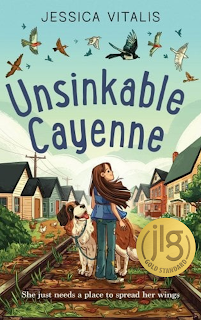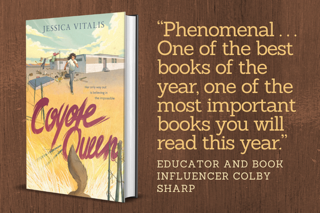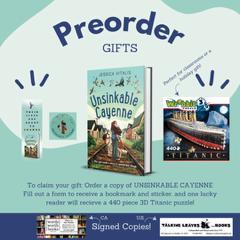Interview With Jessica Vitalis, Author of Unsinkable Cayenne
 Thanks for joining us at Smack Dab, Jessica! Tell us a bit about UnsinkableCayenne.
Thanks for joining us at Smack Dab, Jessica! Tell us a bit about UnsinkableCayenne.It’s a pleasure to be here! UnsinkableCayenne is a historical novel in verse set in 1985 (yes, that’s historicalto modern middle grade readers!) It follows twelve-year-old Cayenne, who hasspent her entire live traveling the country with her hippy parents in asticker-covered van. When they finally settle down in a small town in Montana,she vows to make friends with the popular kids, catch her rich crush’s eye, andhide her strange family. But her teacher’s obsession with the newly discoveredTitanic wreckage reveals startling parallels between the social strata aboardthe doomed ship and Cayenne’s own life, forcing her to evaluate who she reallyis––and who she wants to be.
I love novels in verse. For me, they kind ofstrip away all the pages of description and let the emotionality of a storyreally resonate. Why were you drawn to writing a novel in verse? What’s thedrafting process like for a novel in verse?
I wrote quite a bit of poetry in high schoolbut never thought of myself as a poet; in fact, when verse novels first tookoff, I was completely in awe of the form and distinctly remember declaring thatI could never write a novel in verse. Unsinkable Cayenne actuallystarted as a short story I wrote for an anthology about first kisses; when Isat down, the story came out in free verse (mostly non-rhyming poetry withoutset rules). My editor passed on the anthology but said she’d be interested in mystory as a novel. I set aside my fear and did a deep dive into verse novels,reading (and rereading) everything I could get my hands on. Once I realizedthere wasn’t some secret set of “rules” guiding verse novels that I simplydidn’t understand, the project became a lot less intimidating. From abig-picture perspective, the writing process was identical to writing in prosein the sense that there needs to be a compelling plot and a solid characterarc. The main difference is that writing in verse allowed me to spend a lotmore time exploring the image systems and poetic techniques designed to evokeemotions in readers, which was a fun challenge.

I love the Titanic angle–linking it to Cayennein a strong way (Unsinkable–it’s right there in the title), but I also lovedthat you included some of the survivors. Showing that it’s possible to make itthrough something disastrous. Where did the Titanic angle come from?
The short story I mentioned earlier was basedon a crush from my childhood in the 1980s. When I set out to turn the storyinto a novel, I wanted to keep the flavor of the story (roller skating, PizzaHut, perms, etc.) but conventional wisdom holds that there has to be a reallycompelling reason to make a story historical. Since friendship, first crushes,and fitting in could easily be contemporary, I knew I had to find a historicalanchor. My very first Google search revealed the discovery of the Titanic wreckagein 1985, and the theme fit so perfectly with the story I was trying to tell interms of exploring the impact of socio-economics on the middle schoolexperience that I never looked back.
Lyrical writing abounds here—to a great extentbecause novels in verse lend themselves to it. Same favorites: “maybe is thesound my heart makes” or “the sour taste of never.” Does lyrical writing comenaturally? How do you strike a balance between making a book pretty and slowingit down?
First of all, thank you! I do think I tend tohave a fairly lyrical writing style, so that was useful in making thetransition to verse. In terms of pacing, I think it’s critical to have a goodsense of story structure (developed by being an avid reader and intentionallystudying craft); beyond that, feedback from critique partners and my editor wascritical in getting the balance right. Although I’m typically an underwriter,we actually ended up cutting dozens of poems in the later stages of thisproject.
Without spoiling anything, tell us a littlemore about how you arrived at the ending.
The hallmark of middle grade books is that theyalways end on a hopeful note, but I didn’t want to write something that wouldgive kids false hope or suggest that they are somehow responsible for, or ableto influence, their parents’ decisions. The very first draft of this novel hada “happily-ever-after” ending, and I think I knew even as I was drafting thatit wasn’t right for the story I wanted to tell. In the end, I chose to focus onCayenne’s emotional journey rather than external factors that are entirely outof her control.
What’s next?
Good question! I have several projects in theworks, but after publishing 4 novels in 4 years, I’m taking a bit of a breatherand focusing on getting the books I have out into the hands of young readers. Ihope to do lots of school visits, conference, and festivals in 2025, sohopefully I’ll have a chance to meet you and many of your readers IRL!

Where can we find you?
The best place to find me right now is at www.jessicavitalis.com; I’m alsosemi-active on Instagram and Facebook at @jessicavauthor. Thanks for having me!




